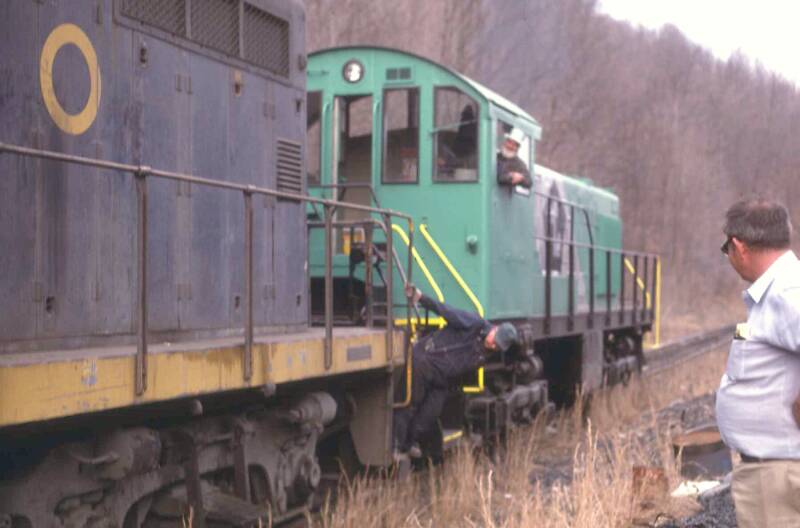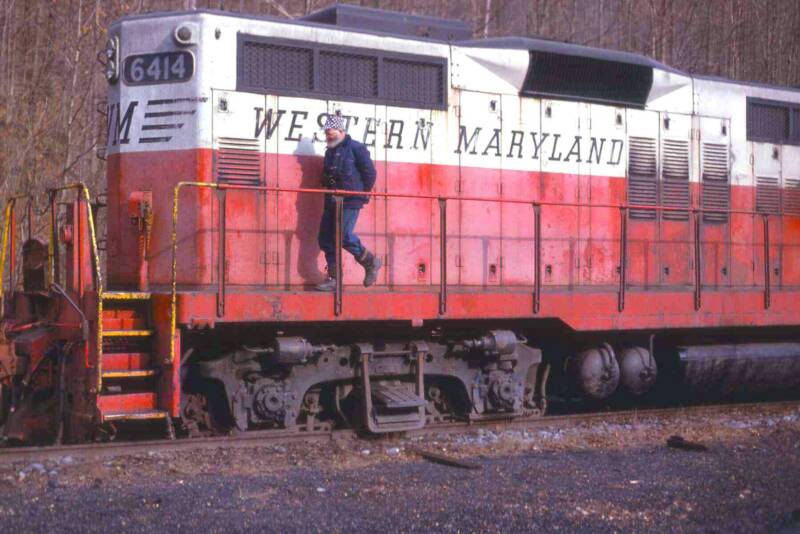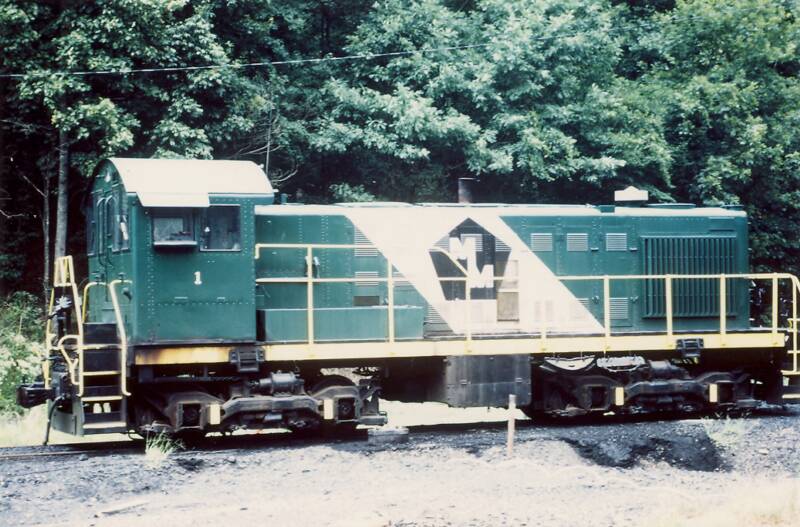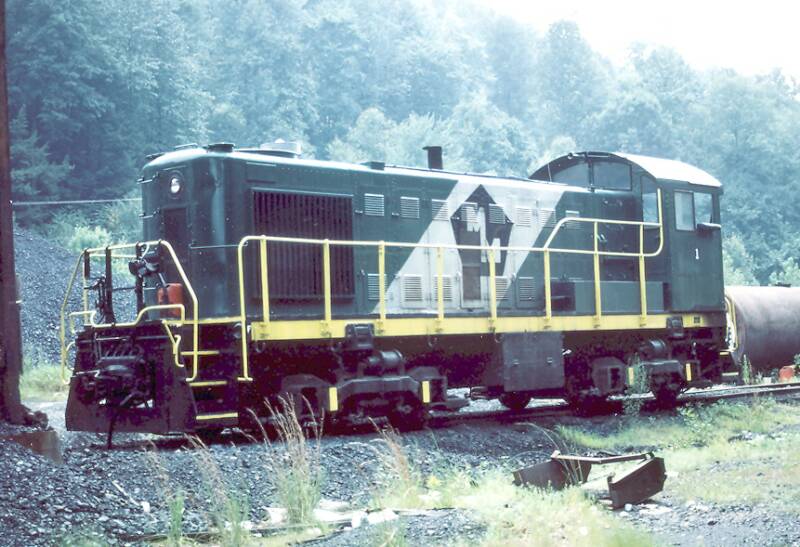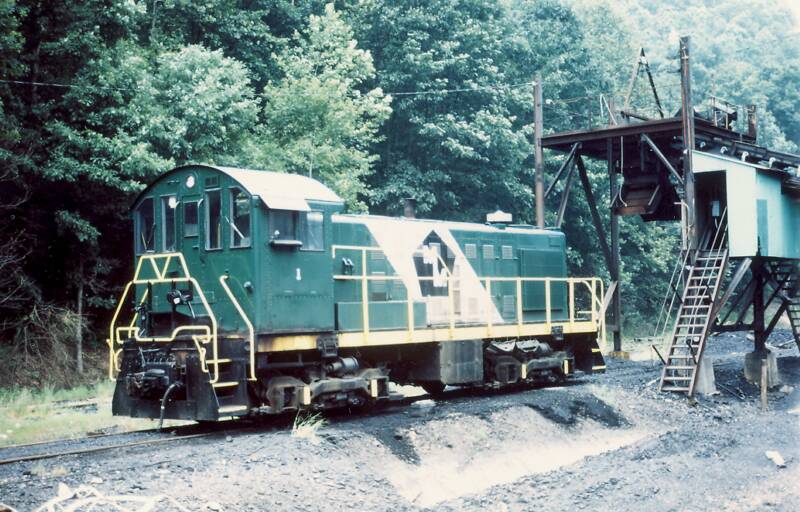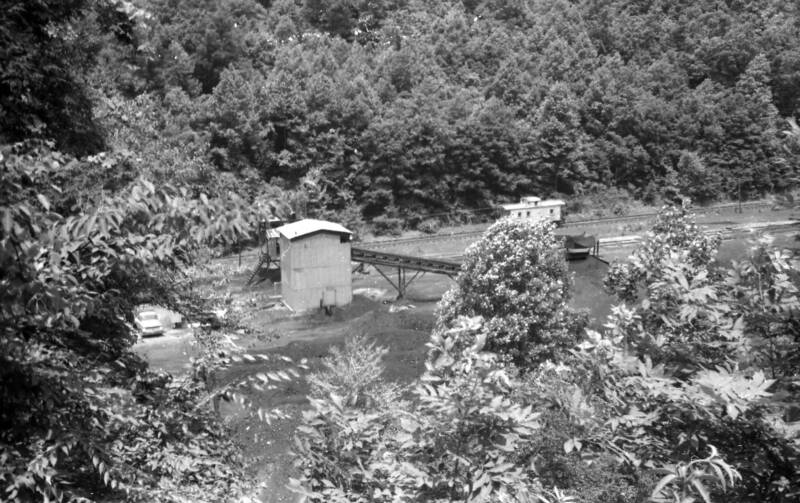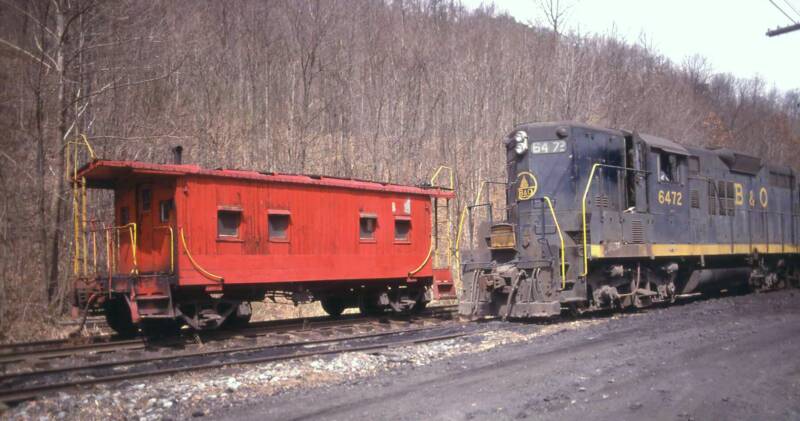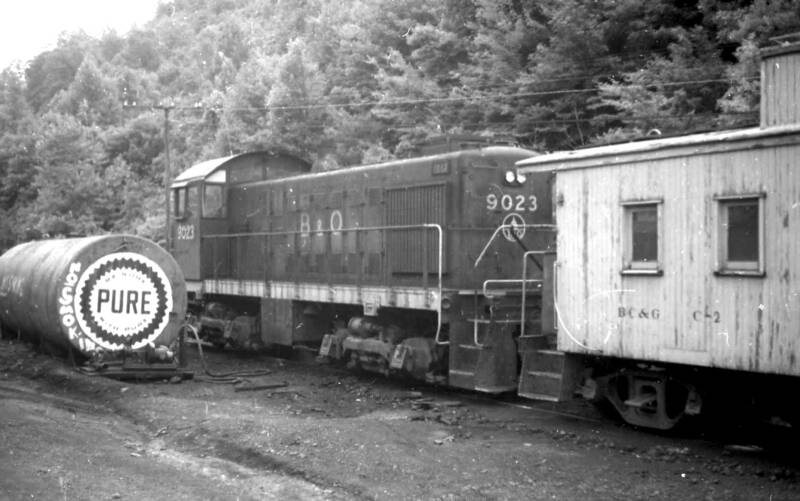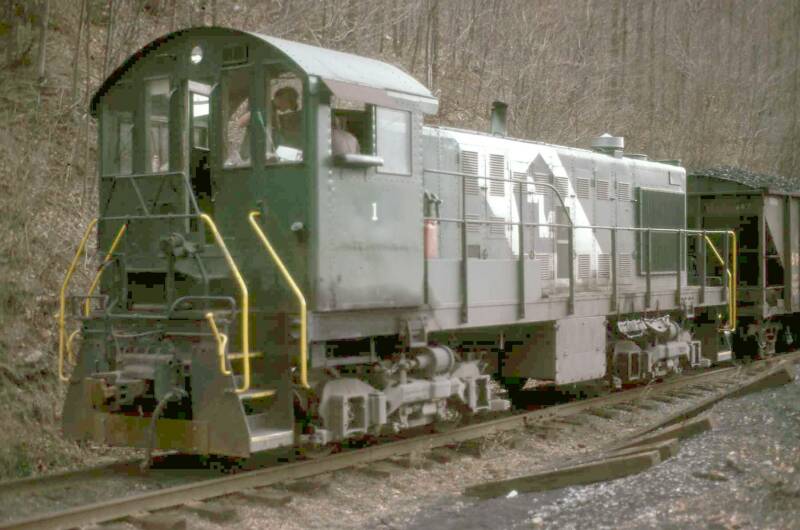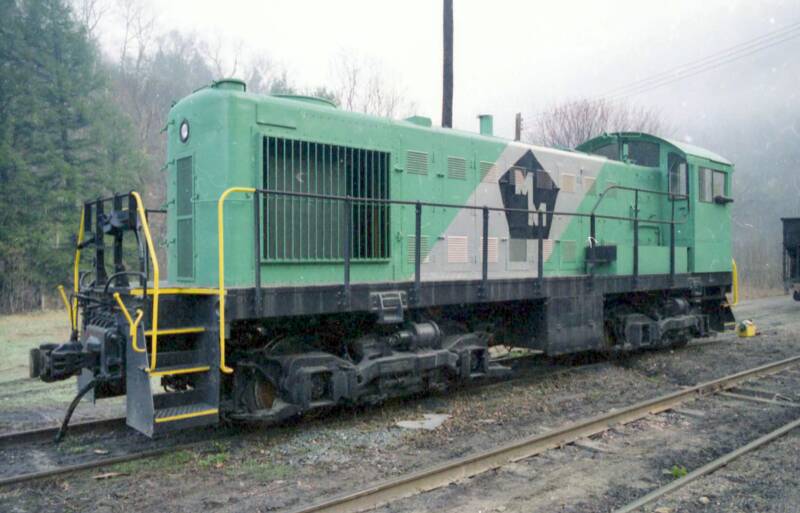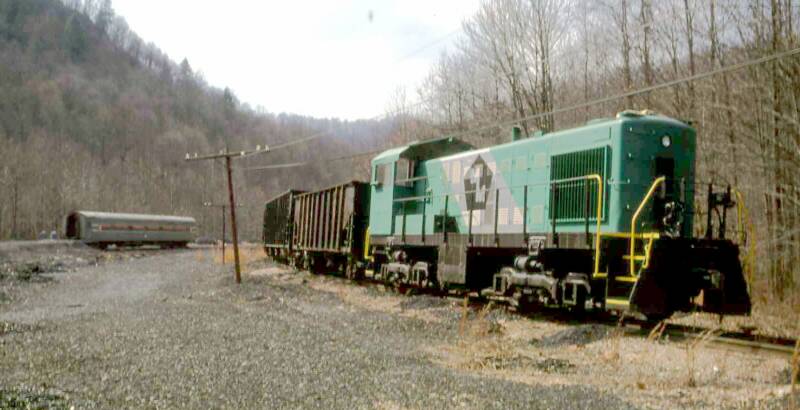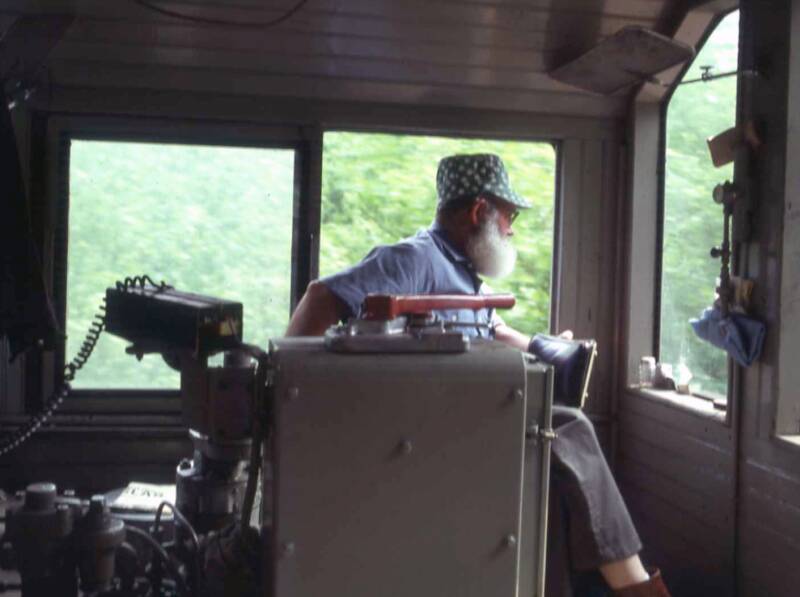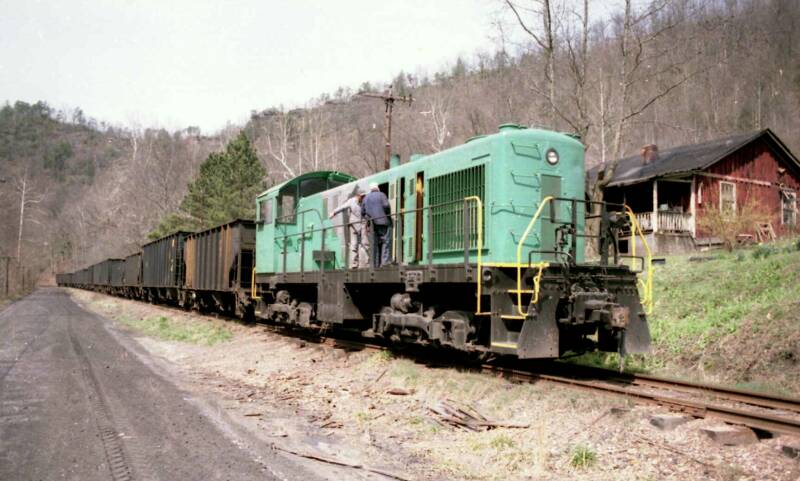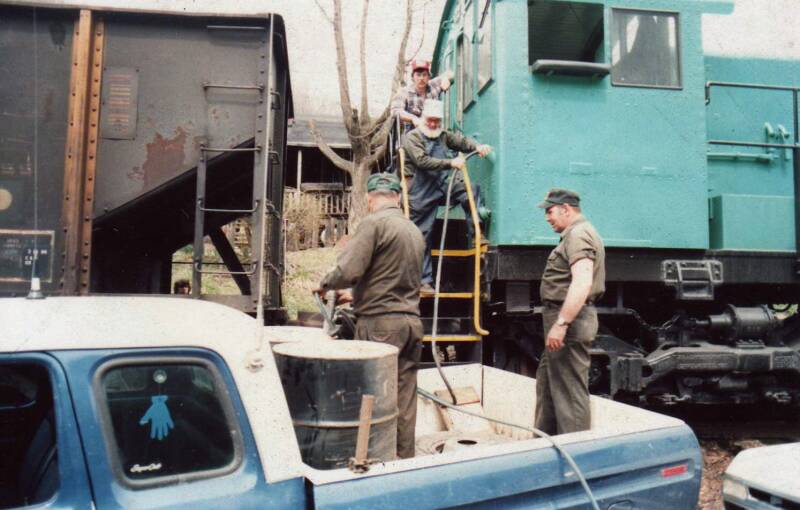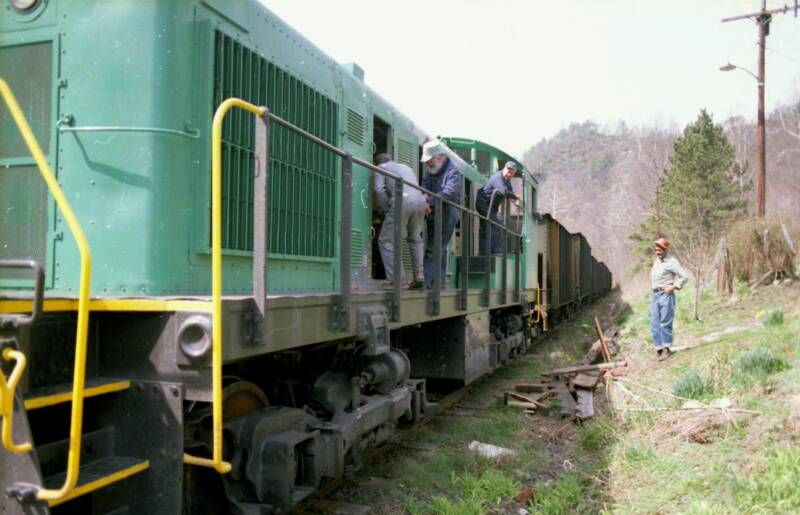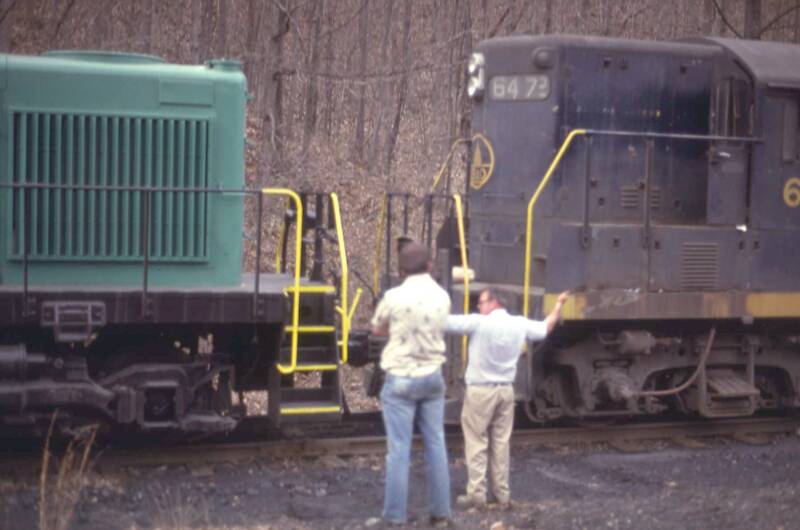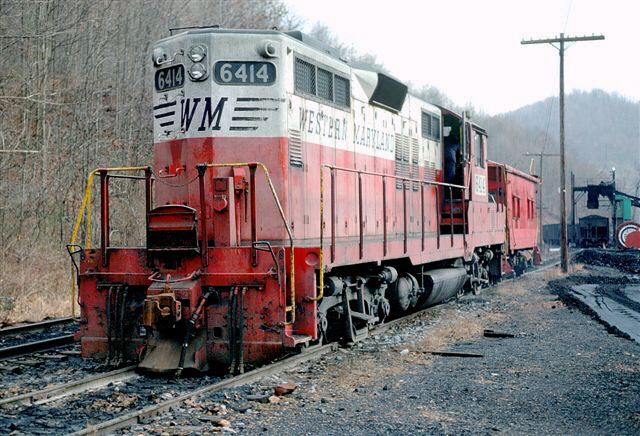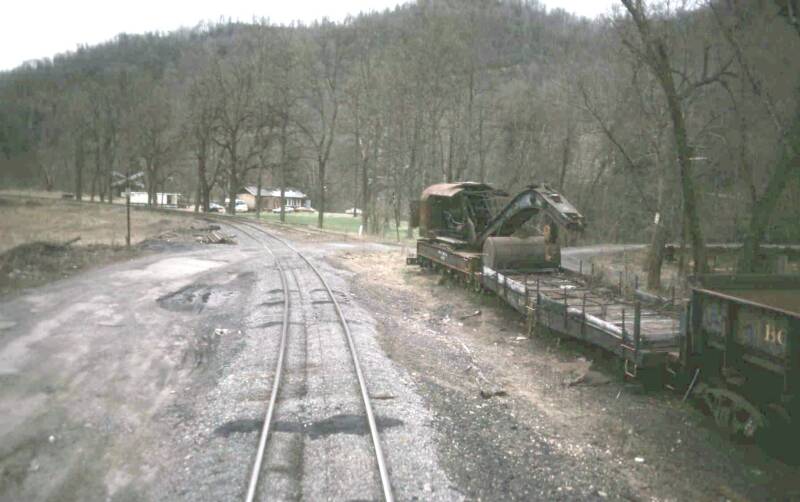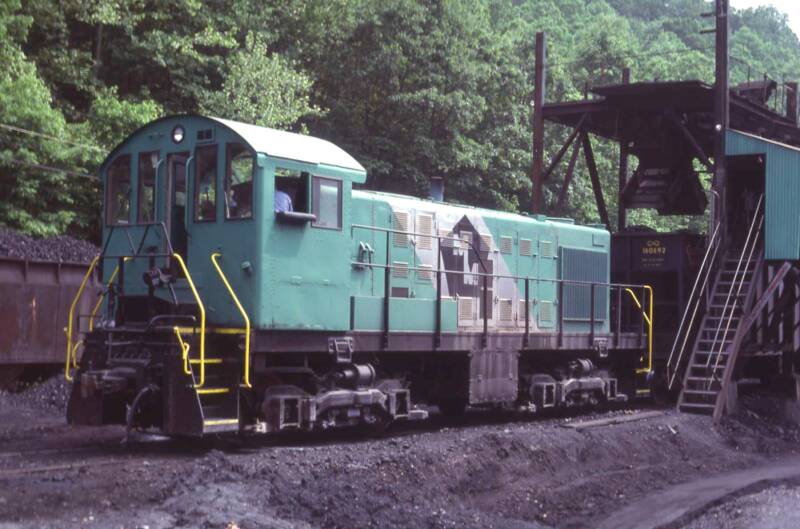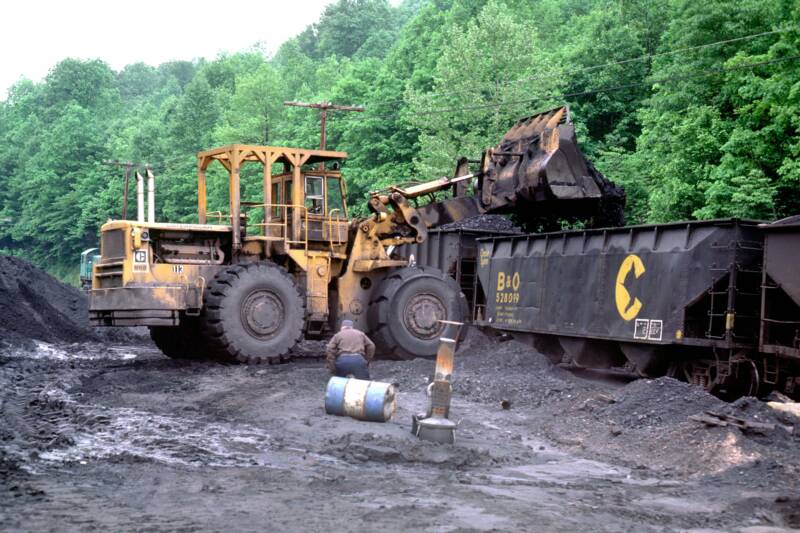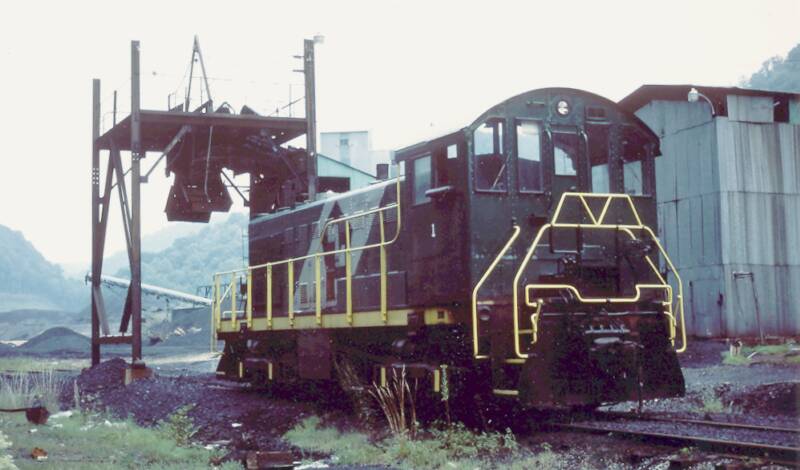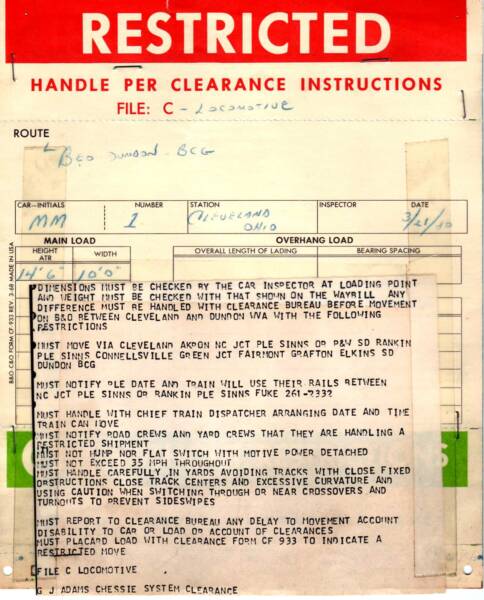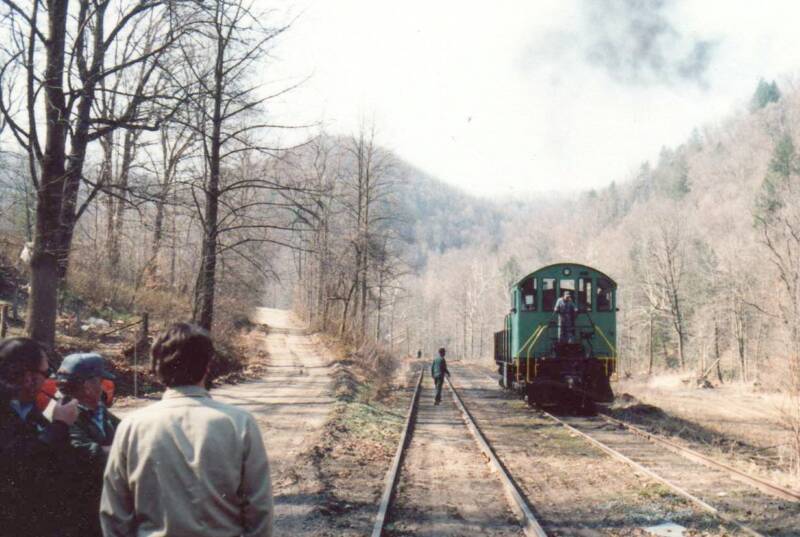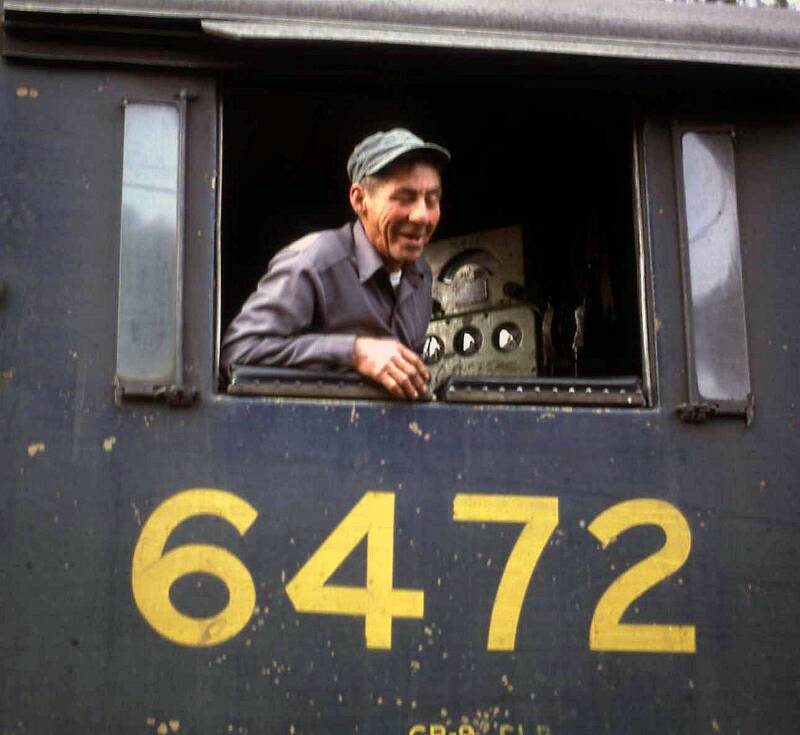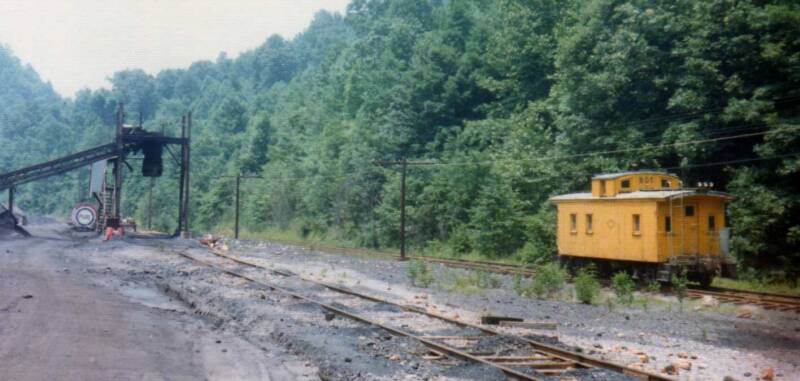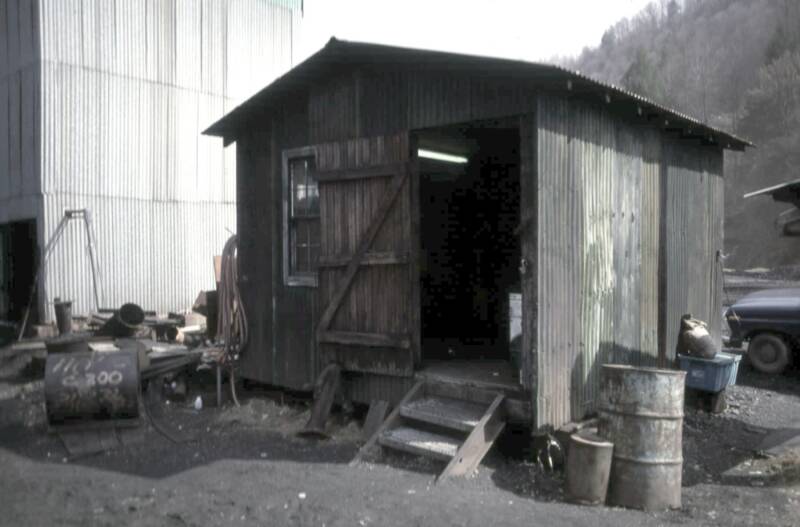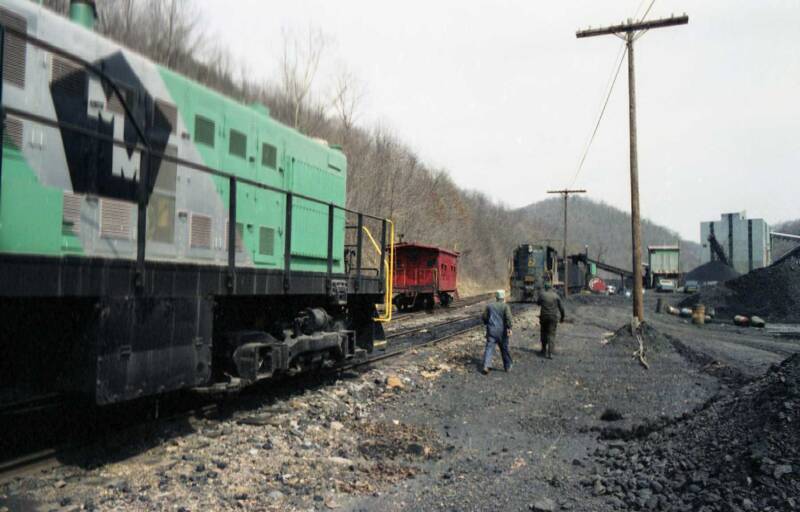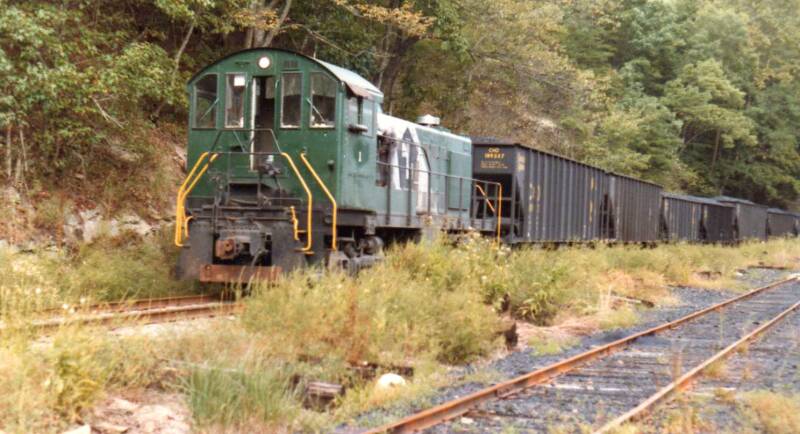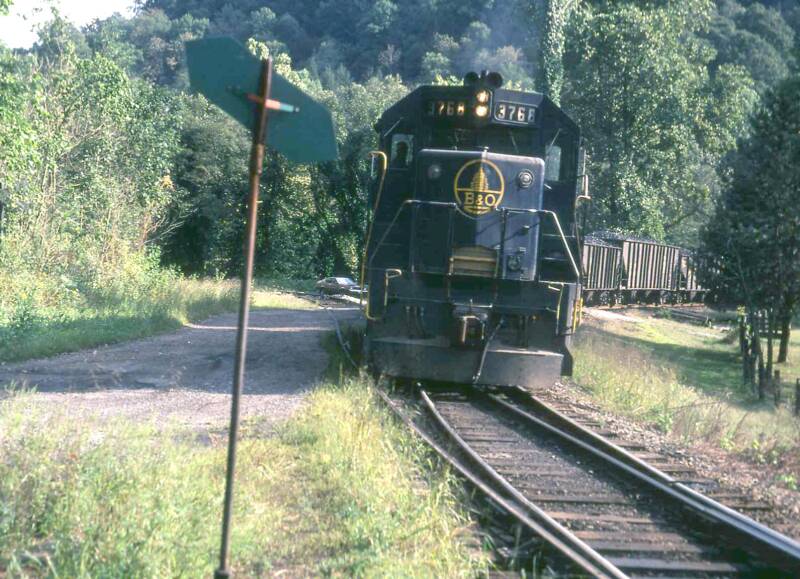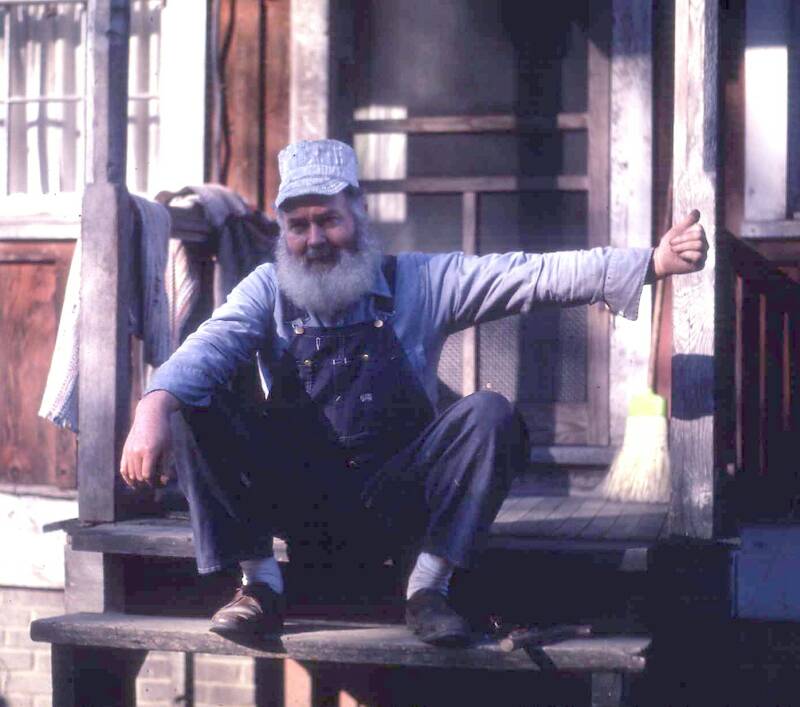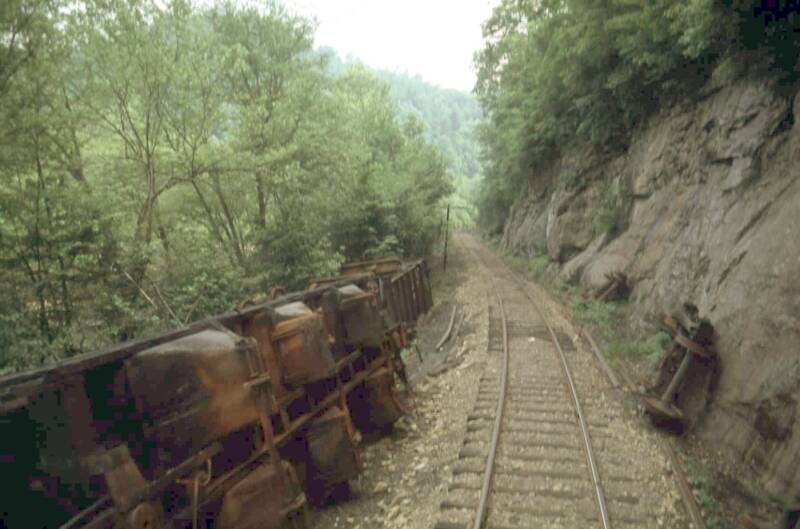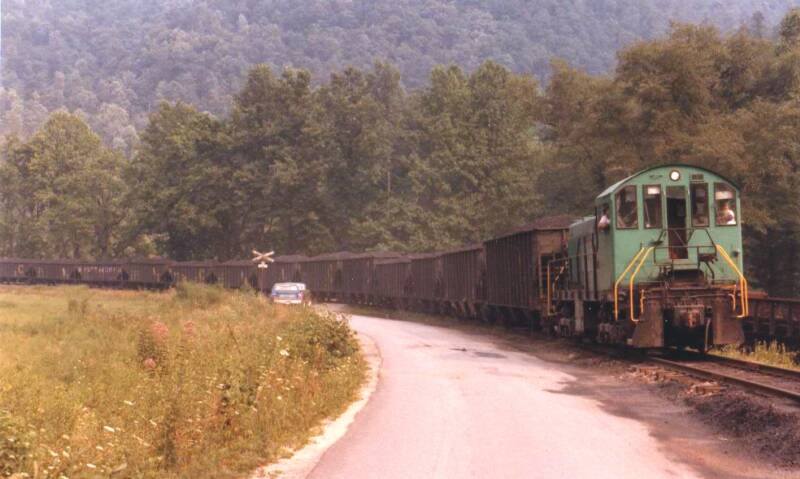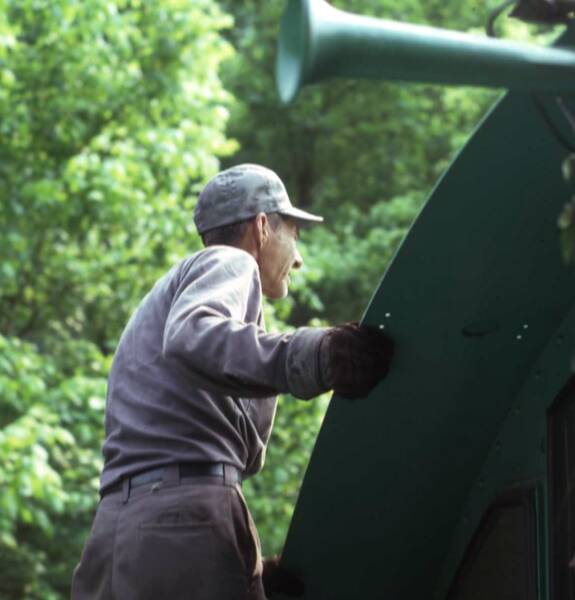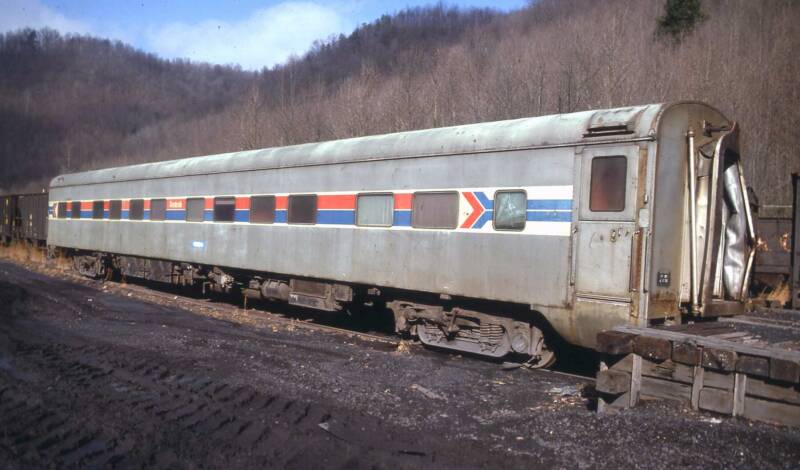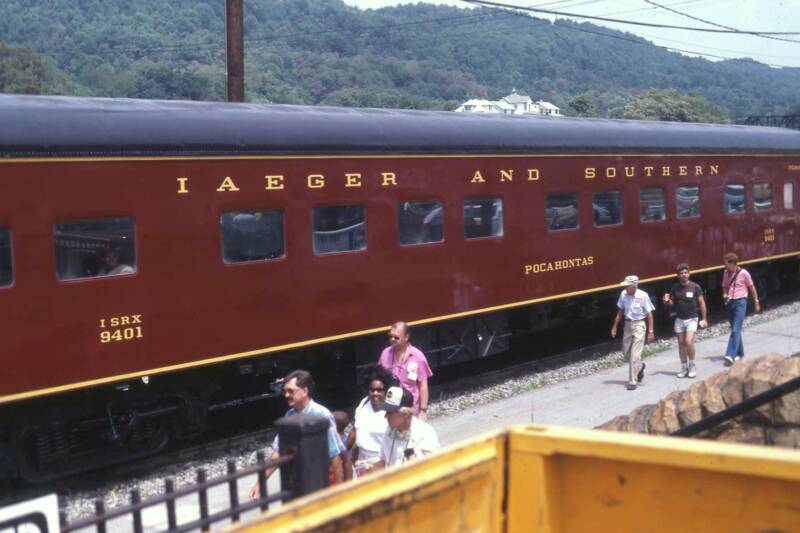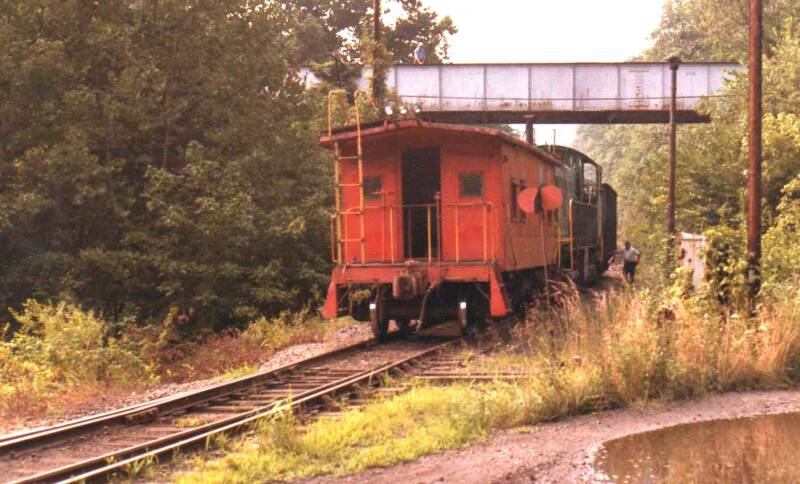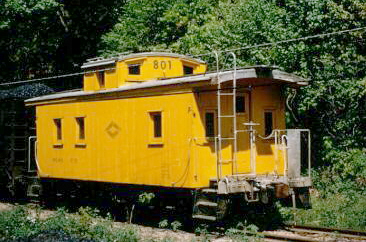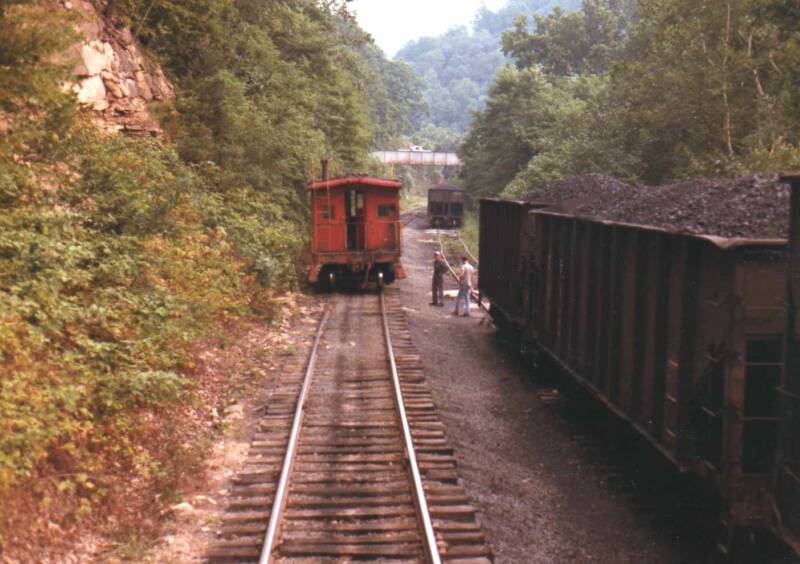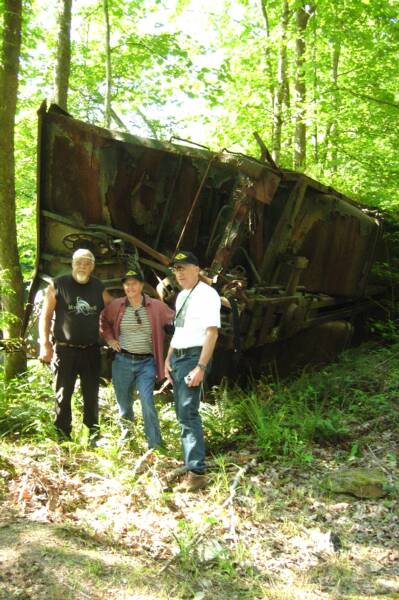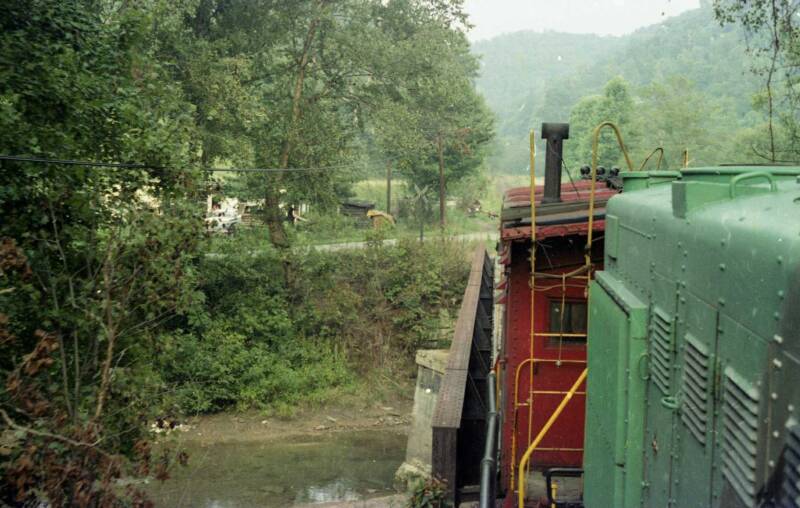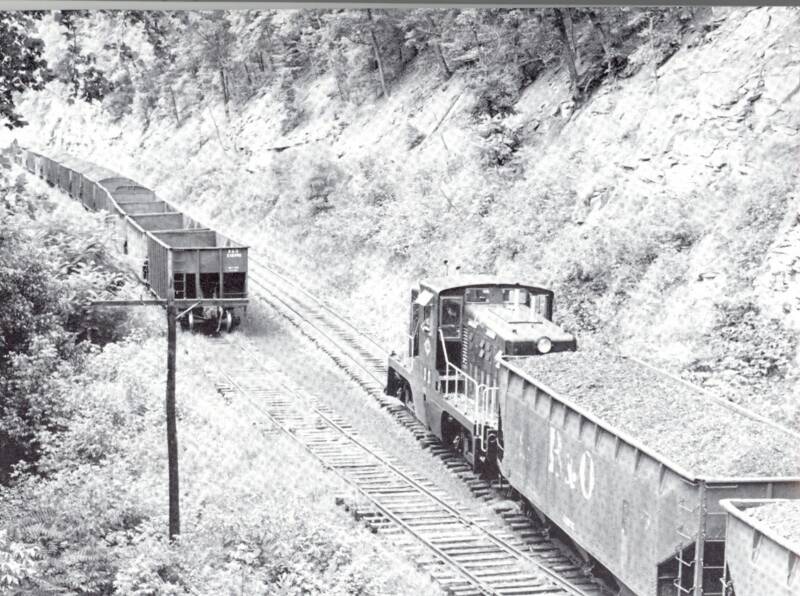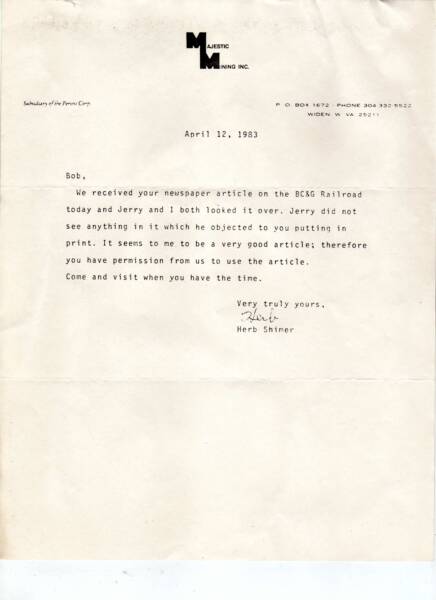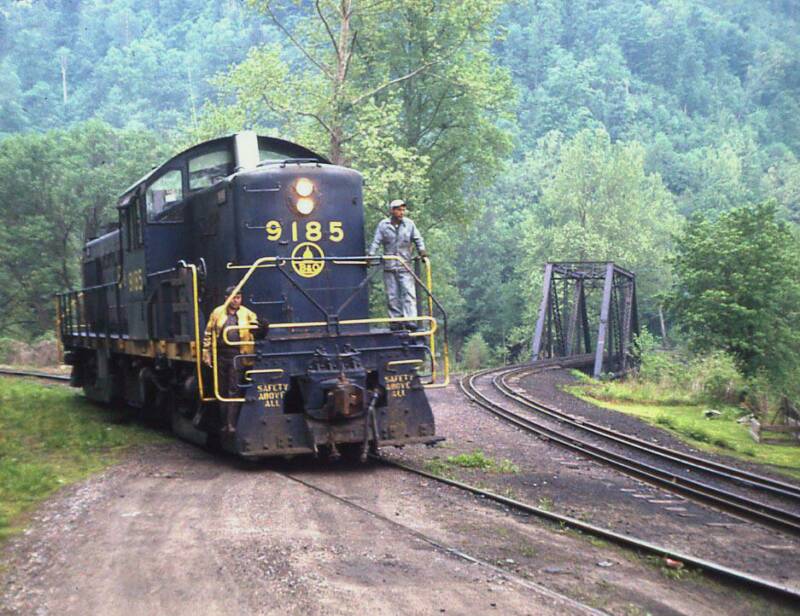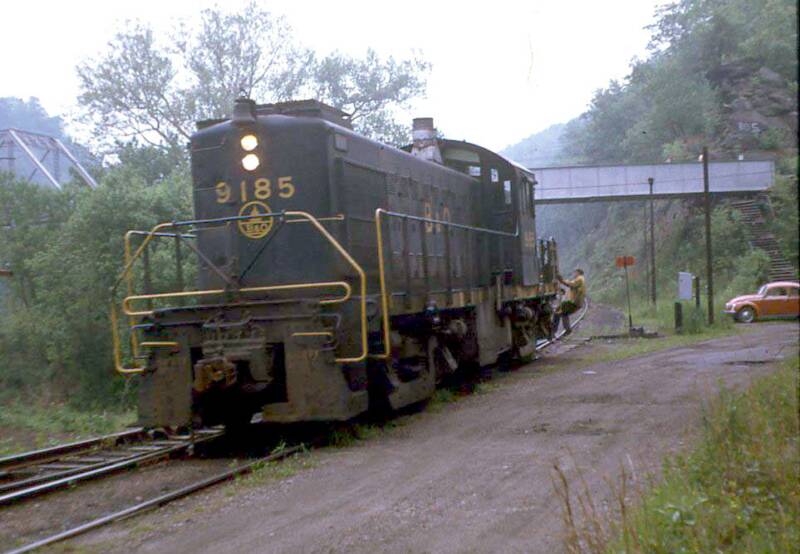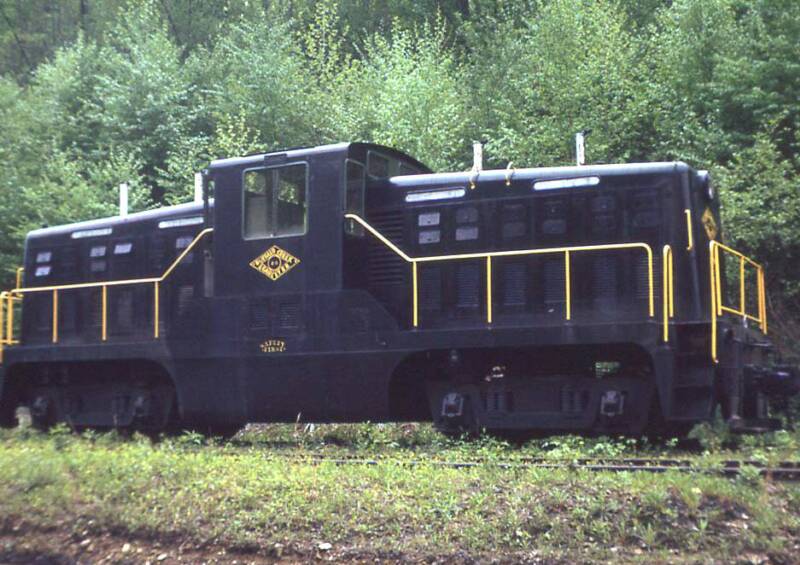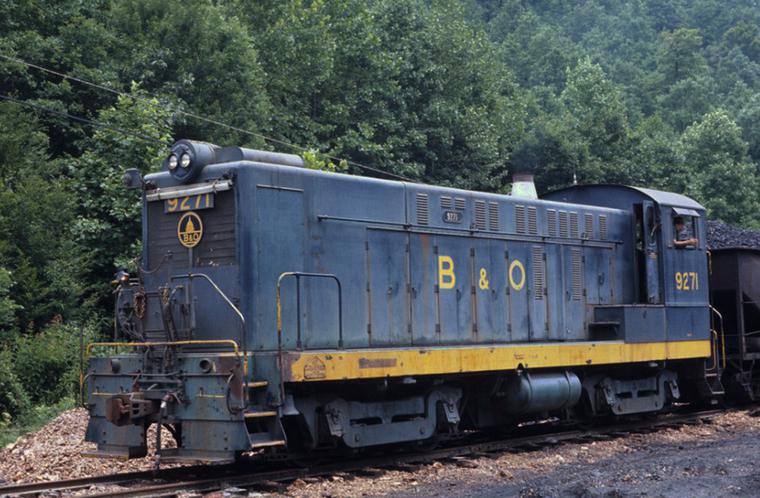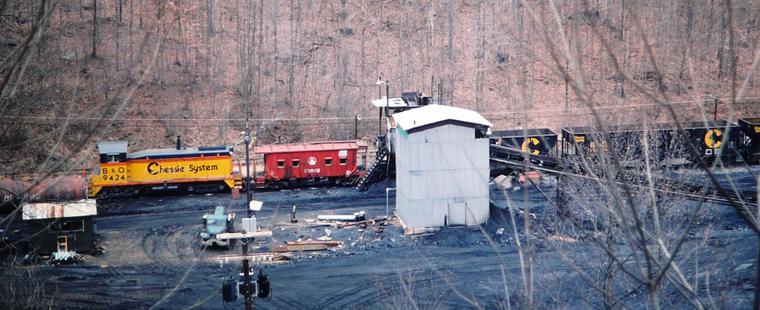The view off the pilot as MM #1 departs Dundon for Widen for the first time. Notice crane X-5, flat #108 and a Clark gondola on the siding.
History - 1971-85 Majestic Mining
When the BC&G ceased operations in November of 1965, some thought the end had come. However, there was still life in the old railroad! In August of 1971 the BC&G was rechartered and operated by the Majestic Mining Company who leased a strip mine about 2 1/2 miles below Widen and the railroad from Clinchfield Coal. I knew little about this obscure period of the railroad and up until recently I thought few photos existed. Then I was contacted by Mr. Bob Slavy who made many trips to the line during these years. Bob became good friends with Bobby Caruthers, ex-BC&G hostler, along with Carsel Hamrick and Ashton Woods, also former BC&G employees. Many thanks to Bob Slavy for the many photos he has provided as well the wonderful stories he has passed along about these nearly-obsure years on the railroad. Jerry Wardwell was the General Superintendent of the railroad. The Majestic Mining operation ended in 1985.
The first engine that the Majestic Mining Company operated was the 65-ton Whitcomb #20. It was built in 1943 for the Pennsylvania Ordinance Works. The engine was painted black and interestingly carried the BC&G diamond logo. The number is also curious since back in the mid-60s the ERC&L had operated a Plymouth diesel that also carried #20.
In a 1993 interview, Bobby Caruthers indicated the crews called this engine "Peanut". Bobby made the point that it could not pull many cars (obviously, not compared to one of the Consolidations!). Bobby also said that the engine had leaky radiators and that stops were sometimes made to top off the radiators using garden hoses from homes along the line.
This photo is from page 12 of Warden's BC&G book and is one of the few that shows #20 actually in service, in this photo at the interchange.
The four photos above by John Steenwyk were taken in September 1987 after operations had ceased. This was the final paint scheme for the engine. Notice the yellow journal boxes. The cleaning washer plant is visible in the rear.
Engine #20 - "Peanut"
Leased Locomotives
Once the strip mining operation was going in full swing, it became obvious that "Peanut" was not going to cut it. The little engine could only handle about 10 loaded cars. To meet its power requirements, Majestic Mining set about leasing bigger engines from the B&O. Between the retirement of #20 around 1974 and the acquisition of MM #1 (see below), a number of engines of different manufacturers and road names serviced the Majestic operation. Three of the engines appear in the Bob Slavy photos below including B&O ALCO S-2 #9023, WM GP #6414 and B&O GP #6472. Other leased engines included ALCO RS-1 #9185 and #9186 and BALDWIN #9271.
It was a far cry from the Rich Run Mine, but this was the loading tipple for the Majestic Mining Company. It was located in the area known as Bonetown Gap just east of Eakle and about 2 1/2 miles below the town of Widen. That's caboose C-2 (#801) (see below).
The period of 1904-1965 represented the 'golden years' of the BC&G. But an equally interesting period was 1971-1985 when the tracks previously trod by the BC&G Consolidations carried diesel power. Interestingly, the trains were just as long...60 cars or more. And for the modeler, there was a wide array of locomotives to be seen. This is the story of the Majestic Mining years...and they were fascinating.
Four photos by Bob Slavy
DERAILMENT STORY - By Bob Slavy (see photo above left)
"Bobby Caruthers took my wife and I in his truck up to see the "pretty red and white engine" that they had at the time. It was a Sunday and since I drove an MG sports car we took Bobby's truck. My wife had not ever been on a train, let alone a moving train before. The engine was under the loader so he said since he had to start it anyway he would move it out for a better picture. When we were in the engine my wife asked 'what's in here' pointing to the small nose door. Bobby had started the engine moving slowly and came over to show her the small hopper (rest room to her) inside. Then it happened...we ran over a derail! I felt so bad for Bobby just trying to be nice to me and this happened. On the next visit I learned from Joe Wardwell that it took 18 hours to rerail the engine by jacks and hard labor! My wife's first train ride and she derailed the engine!
WM #6414 'on the ground' after running over a derailer! (see story below)
Majestic Mining Engine #1
Bob Slavy wrote a wonderfully colorful article about the acquistion of Majestic Mining #1 which appeared in the April 1983 issue of West Virginia HILLBILLY newspaper. Major portions of that article (appearing on green) are reproduced here to tell the story of MM #1. All photos by Bob. Thanks, Bob, for a wonderful account of what must have been a truly memorable day!
"On March 21, 1980 the Majestic Mining Coal Company rceived one newly rebuilt diesel locomotive. Jerry Wardwell, General Superintendent of the railroad and of the coal company wanted some pictures of this new addition. I had been taking pictures of this railroad since 1974 so I was familiar with it and the hospitable people of the Clay County area.
When the need for power bigger than "Peanut" was clear, Wardwell determined that a rebuilt engine was the best solution.
Some men from General Electric in Cleveland were invited down to look over the operation. Their recommendations for the line's inherent difficulties such as the number of heavy grades, number of cars loaded each day and the condition of the track were designed into one locomotive. An Alco S-2 body and frame were used, a Catapillar 992 diesel engine (same as engines in the equipment at the strip mine) and extra weights proved to be the answer."
"Upon delivery I found the new engine at 6:00 that morning sitting on the BC&G siding at Dundon awaiting its crew all newly painted silver, black and jade green. Three men from G.E. were to meet the railroad crew, Mr. Wardwell and myself at 7:00. These men were to start up the engine and show the crew how to and what everything did.
The first of many problems of the began to happen. The G.E. crew could not be found and it was almost 8:00. I went with Mr. Wardwell in his car and found a blue suburban with three men and Ohio tags wandering around lost in the town of Clay. Now Clay is bigger than Dundon but I guess Cleveland is a whole lot larger than Clay. Anyway, we pulled them over and headed them toward the engine."
"Once there some obvious parts that had been missing during shipment were put on by the G.E. people such as throttle and reverse levers. The diesel engine would not start. A quick trip to an auto parts store for some ether to spray on the air intake vents, a few more cranks, some mor switches flipped, levers pushed and presto...black smoke!
Now with this all going on, the BC&G boys weren't just looking on. They had been around more complicated equipment than this - remember Dundon in the 60's and steam! Carsel Hamrick, jack-of-all-railroad-trades, and today's conductor, was also pushing switches and moving levers. when all the G.E. men were away from the engine, Carsel got the brakes to work. Something was said by someone later as to why G.E. sent these guys here in the first place!"
Now to say that this engine was meager in equipment is an understatement. The gauges looked as if out of a Whitney parts catalog and the crew, with the exception of the engineer, stood as only one seat was installed."
MM #1 on the morning of March 21, 1980
The "GE men" on site to show the BC&G crew how to run the new locomotive.
Derailment!
"After coupling onto fifteen empty coal cars and after pumping up the air, we moved towards Widen. The brakeman, Ashton Woods, was to drive Mr. Wardwell's car to the first grade crossing at Cressmont so Wardwell could ride the engine and we would stop for them to change places. Upon moving out of Dudon I went to ride on the front of the engine. It seemed as if we were going sixty but we guessed wide open was about 30 mph since there wasn't a speedometer in the cab. With the fifteen empties in tow and where the first part of the grade started, we slowed to a walking pace!
This engine is supposed to pull 70 empty coal cars up to Widen and Mr. Wardwell's reaction to the present speed was on of "I am glad we haven't paid for this thing yet!" We finally arrived at Cressmont about eight miles from Dundon and stopped."
"With the crew and myself we proceed off to Swandale. It was here at Swandale that we wanted to get pictures of the crew putting sand on the engine for extra traction. We never quite made it as about a half a mile from the sand house we quickly, yet gently, slowed to a stop. We stopped in front of a nam's house who makes his living by selling dray moss to another man for 17 cents a pound. The crew's name for him is "Ambitious". Now think about how much moss it takes to make a pound, a dollar, or a living for that matter! Ambitious was known to throw rocks at the engines if Bobby forgot to blow the whistle when passing his house, too! (see photo below)
To make a long story short, we had run out of diesel fuel! The fuel gauge is outside on the tank and no one thought to look because surely G.E. would fill up a new engine!"
"Telephones in Swandale are few and it was apparent that Ambitious did not have one. So the conductor caught a ride on a road grader into Swandale, the only thing on wheels that went past us on the road into Swandale in the three hours that we were stopped.
Help arrived in the form of two pick-up trucks and two additional men. One was a service truck used to work on the big trucks on the strip job. With some bleeding off of some air at the diesel and some fuel from two fifty-five gallon drums via the compressor, we started, again.
The mine from Swandale is about five miles by rail and seven by highway. The new orders from Wardwell were for the conductor and brakeman to go with one driver and both trucks back to the mine. The reason was to load coal as the leased B&O engine was still on the property. Since our schedule was off from the start, this was the only way to get the job done because the train crew was used to loading the coal. This then left Bobby Caruthers, engineer, the mechanic and myself on the engine.
Now back to running the railroad. Remember the sand I mentioned before? Well, I not only didn't get any pictures of the "crew" loading, but I had to help with the job myself. I migh add that "had to help" is not as it sounds as I was delighted to help because I enjoyed every minute of this day."
"This turned out to be a rather warm day in March and by now it was starting to get hot being on the engine. When we stopped for sand the fun began. This small building along side the track painted oxide red and still lettered BC&G was where the sand was stored. My question as to how to get the 50 pound bags of sand to the top of the engine was soon answered by placing 2" X 10" planks from the ground to the engine steps. Bobby was on top, the mechanic on the walkway of the engine and I was to walk the plank.
After twenty-three bags we filled the sand boxes and again we started. I was exhausted as we slowly left the remains of the once-great sawmill in Swandale behind."
"Bobby was at full throttle and we were barely moving. He would sound the horn around each curve so as to warn the track crew ahead that we were approaching. It's not as if they needed warning with all the noise that we made running at full throttle.
After what seemed almost an hour we were at the cleaning plant.
The engine proved to be what G.E. had promised after more bugs were worked out and it was then purchased by the company. The engine did pull 70 empties to the mine and eighty loads out even though it was at 5 mph. It was stated by one of the crew about the speed on the engine "that they didn't have anything but time on this railroad anyway".
The test as to how this engine at 900 hp compared to the B&O 1700 hp GP, well, that's another story (see below)." Robert Slavy
MM #1 finally arriving at the loading facility at Bone Town Gap. That's Wardwell's coach in the background (see below).
Locomotive Tug-Of-War
This is the clearance card that was attached to MM #1 when delivered to the BC&G. Notice that even though there was no number painted on the engine, the B&O had given it the #1. Bob Slavy collection.
Ambitious
Bobby Caruthers at the throttle of MM #1
Locomotive Tug-Of-War by Bob Slavy
Here is another wonderful story that few would know about if it weren't for Bob and his pictures. B&O GP6472 was on the property the day MM #1 (still unlettered) made its first trip.
"With the GE representatives standing with mouths wide open, Wardwell told Bobby Caruthers and Carsel to couple the two engines together and see which one could pull the other backwards. Remember, 1000 hp in the Alco and 1750 in the EMD. Carsel and Bobby had a small conversation and then got in the engines, Bobby in the Alco and Carsel in the geep. At the start the geep was on the Widen side and the new engine on the Dundon side. There was a grade towards Widen at this point. Wardwell used his boot to draw a line in the ballast (yellow arrow in the photo above left) and then gave the 'go' signal. Bobby pulled Carsel toward Dundon. Carsel cried foul claiming the grade was against him. So Wardwell had them switch the engines around (notice the switched engine positions in the two photos above). Carsel had a smile on his face and off we went again. Bobby again pulled Carsel, this time up hill towards Widen. With this, Wardwell handed over the check to the GE guy. I believe it was $330,000. What a way to run a railroad! I don not know for sure, but I think Carsel and Bobby had a bet on the outcome.
Carsel Hamrick sits in 6472, ready to start the tug of war! Three photos by Bob Slavy
Loading Operations
The Engine Gets Its Number
As mentioned above, the clearance card that came with the engine showed it as #1, but the number was not painted on the cab for nearly two years after it arrived. In that time the engine was also changed from jade green to a darker shade. The father of a friend of Bob Slavy's was, at the time, an inspector for the FRA. He made a trip to Widen and directed that two changes be made to the engine to make it conform to FRA regulations. First was the addition of the road number. Second was the addition of a "cow catcher pilot" which took the form of a simple steel plate mounted under the couplers (see yellow arrow on photo to the right).
Also notice the turban vent over the exhaust stack in the photo to the right. This was added by the BC&G crew to draw hot air off the traction motors.
The loading of coal from the strip mine operation took place at a simple facility near Bonetown Gap. Initially, coal was loaded by front loader, but as production increased, a slightly more sophisticated operation evolved. Coal was sorted by size at a small tipple (washer) and placed into piles by size on the ground. The coal was then transfered by front loader to a conveyor to the simple loading facility seen in these photos.
The train crew did the loading. Carsel ran the loader and Bobby ran the engine as the cars were not dropped. A floodlight on the loader was used to tell Bobby when to pull forward. Loading of the individual cars was done "by eye", according to Slavy.
The photo to the right was taken before the engine got its number. Notice the loads on the track behind the engine.
Photos by Bob Slavy
B&O #9023 and caboose C-2
Two more Bob Slavy photos fill in the details around the loader. On the left is a shed Bob refers to as the "loading crew and train crew lounge/break room". It contained a couch, tables, fridge and chairs. Nice digs, eh?
The photo of the right shows more clearly the conveyor that carried coal up to the loader and a nice view of C-2.
The photo on the right shows the B&O Geep shuttling hoppers under the loader while MM #1 looks on. The size of the coal cleaning facility is apparent in this picture.
Operations
Cabooses
During the Majestic Mining operations, two different cabooses were apparently used. Yellow BC&G caboose C-2 (right) was apparently around from pretty much the beginning. Curiously, this caboose has the number 801 on the cupola as well as the BC&G C-2 designation. At some point, Jerry Wardwell took this caboose and turned it into his office.
C-2 was replaced by the red unit seen below. Bob Slavy's research suggests that the B&O rostered a few cars without cupolas or bay windows. These were apparently for chicken caretakers to ride in. Bob says this car actually smelled a little like chickens and rode very rought. The crew installed a oil stove. It apparently had no number.
Date and photographer unknown
Two photos by Bob Slavy
The operations during the Majestic years weren't too much different from the "golden years"....empties from the B&O interchange to the loading facility at Bonetown Gap and then loads back to the interchange. Bob Slavy gives the following accounts of the operations:
"It took all day to load, maybe even two, depending on how well the trucks and later the tipple were running. Trains almost always left (Dundon) in the mid-afternoon and returned after dark. Wardwell would call over or come by and say whether the crew would have to wait for the empties from the B&O or come back light. The norm was one train three to four times a week, although occassionally two trains a day were required to meet demand. Sometimes the Majestic would fill an order for a customer and the B&O could not pick them all up so the cars would be stored between Avoca and Dundon on a siding.
"Maximum speed along the mainline was generally 10 miles per hour and a stop was always made at Swandale on the return trip to release the brake retainers. The engine was never turned and spent the night at Bonetown."
Out on the mainline at track speed with 80 cars in tow...just like in the steam days! Bob Slavy photos
"The interchange was used several different ways when I was there. One was that the BC&G went out on the B&O and put loads on the #1 and #2 interchange sidings and then waited for the B&O to show up with the empties. The second way was the BC&G would uncouple from the loads at the Dundon switch, move into siding #1 with the empties that the B&O had just brought and the B&O would couple onto the loads on the BC&G track. At times the B&O would run their power all the way down to the siding at Avoca if loads had been left there and pull the loads out themselves, but with the BC&G crew nearby. The BCG crews were union but didn't abide by too many of its rules."
Action at the interchange.
Carsel looking for empties on the B&O.
Here is B&O 3768 at the Dundon switch with loads in tow. This track is still in place today. The dirt road is also in place and leads around to the site of the former BC&G shops, now J.G. Bradley campground of the BC&G Cooperative.
All six interchange photos by Bob Slavy
The Last Train Wreck
Sometime around 1981 sevral hoppers derailed out on the BC&G main. I don't have the specifics of the date, the cause, or how many cars left the rails, but the photo on the left shows some of the damage. The cars in the picture were eventually removed, but one that rolled partway down to the creek is still there as seen in the small photo taken in June of 2007.
This is believed to be the last known derailment on the railroad.
The Pocahantas
How about an Amtrak sleeper on a mountain shortline? Once again, Bob Slavy can tell the story. This car belonged to Jerry Wardwell. He used it to haul "coal people" around. It is a 10 bedroom sleeper and was built in 1950 for the SP to run the north coast. It was later sold to Sid Bailey of Iager, WV, who spent over $100,000 to restore it to the condition in the second photo. It has been used regularly in railfan service lettered for the Iager and Souther and named the "Pocahontas".
Photos by Bob Slavy
The Consumate Railroader - Bobby Caruthers
It's fitting to end this discussion of the final years of the regular operations of the BC&G with this wonderful portrait of a man who embodied the can-do spirit of the railroad and the hospitality of the folks who worked on the railroad and lived in the communities it served...Bobby Caruthers.
Many of the folks who have contributed information to this site, myself included, considered it a priviledge to have known him. Bobby was always eager to share what he knew about railroading with anyone interested in listening.
Bobby Caruthers WAS the BC&G to many of us!
Thanks to Bob Slavy for this wonderful portrait!
The BC&G crew never called the B&O for permission to proceed onto their tracks in the diesel era. As Carsel Hamrick said "They just watched out for one another and sounded the horn sometimes."
Film of Final Journey
On May 11, 1989, Majestic Mining #1 made it's final journey from down the BC&G tracks. The entire move is documented on film and can be viewed at the following website:
Here's a great photo taken from onboard MM #1 crossing the Cressmont bridge in route to the loader at Bonetown. As was the custom, the train proceeded to Bonetown with the caboose AHEAD of the engine and the empty hoppers trailing behind.
It was right along here that Bobby would start thinking about whistling for Ambitious's house!
Bob Slavy photo
A rare photo of Majestic Mining #1 side-by-side with B&O power on the interchange (above) and the B&O power at the interchange track (above left) and viewed from the BC&G main (below left)
Operations
Cabooses
During the Majestic Mining operations, two different cabooses were apparently used. According to Dwight Jones' book "C&O/B&O Cabooses-Display and Private Cars" this yellow caboose C-2 was ex-Pierre Marquette/C&0 #801 that was purchased by MM on July 27, 1971 and delivered in this form on September 6, 1971. Notice that while the railroad is now operated my Majestic Mining, the caboose has a BC&G logo. At some point, Jerry Wardwell took this caboose and turned it into his office.
C-2 was replaced by the red unit seen below. It is ex-B&O #1922, a I-5d class caboose. These caboose had a 4' longer wheelbase than the original I-1s, and steel ends. Because they were used in helper service, they had concrete ballast added under the floor to increase the tracking of the cars when being pushed on.
Date and photographer unknown
Two photos by Bob Slavy
The operations during the Majestic years weren't too much different from the "golden years"....empties from the B&O interchange to the loading facility at Bonetown Gap and then loads back to the interchange. Bob Slavy gives the following accounts of the operations:
"It took all day to load, maybe even two, depending on how well the trucks and later the tipple were running. Trains almost always left (Dundon) in the mid-afternoon and returned after dark. Wardwell would call over or come by and say whether the crew would have to wait for the empties from the B&O or come back light. The norm was one train three to four times a week, although occassionally two trains a day were required to meet demand. Sometimes the Majestic would fill an order for a customer and the B&O could not pick them all up so the cars would be stored between Avoca and Dundon on a siding.
"Maximum speed along the mainline was generally 10 miles per hour and a stop was always made at Swandale on the return trip to release the brake retainers. The engine was never turned and spent the night at Bonetown."
Out on the mainline at track speed with 80 cars in tow...just like in the steam days! Bob Slavy photos
"The interchange was used several different ways when I was there. One was that the BC&G went out on the B&O and put loads on the #1 and #2 interchange sidings and then waited for the B&O to show up with the empties. The second way was the BC&G would uncouple from the loads at the Dundon switch, move into siding #1 with the empties that the B&O had just brought and the B&O would couple onto the loads on the BC&G track. At times the B&O would run their power all the way down to the siding at Avoca if loads had been left there and pull the loads out themselves, but with the BC&G crew nearby. The BCG crews were union but didn't abide by too many of its rules."
Action at the interchange.
Carsel looking for empties on the B&O.
Here is B&O 3768 at the Dundon switch with loads in tow. This track is still in place today. The dirt road is also in place and leads around to the site of the former BC&G shops, now J.G. Bradley campground of the BC&G Cooperative.
All six interchange photos by Bob Slavy
The Last Train Wreck
Sometime around 1981 several hoppers derailed out on the BC&G main. I don't have the specifics of the date, the cause, or how many cars left the rails, but the photo on the left shows some of the damage. The cars in the picture were eventually removed, but one that rolled partway down to the creek is still there as seen in the small photo taken in June of 2007.
This is believed to be the last derailment on the railroad.
The Pocahantas
How about an Amtrak sleeper on a mountain shortline? Once again, Bob Slavy can tell the story. This car belonged to Jerry Wardwell. He used it to haul "coal people" around. It is a 10 bedroom sleeper and was built in 1950 for the SP to run the north coast. It was later sold to Sid Bailey of Iager, WV, who spent over $100,000 to restore it to the condition in the second photo. It has been used regularly in railfan service lettered for the Iager and Souther and named the "Pocahontas".
Photos by Bob Slavy
The Consumate Railroader - Bobby Caruthers
It's fitting to end this discussion of the final years of the regular operations of the BC&G with this wonderful portrait of a man who embodied the can-do spirit of the railroad and the hospitality of the folks who worked on the railroad and lived in the communities it served...Bobby Caruthers.
Many of the folks who have contributed information to this site, myself included, considered it a priviledge to have known him. Bobby was always eager to share what he knew about railroading with anyone interested in listening.
Bobby Caruthers WAS the BC&G to many of us!
Thanks to Bob Slavy for this wonderful portrait!
The BC&G crew never called the B&O for permission to proceed onto their tracks in the diesel era. As Carsel Hamrick said "They just watched out for one another and sounded the horn sometimes."
Film of Final Journey
On May 11, 1989, Majestic Mining #1 made it's final journey from down the BC&G tracks. The entire move is documented on film and can be viewed at the following website:
Here's a great photo taken from onboard MM #1 crossing the Cressmont bridge in route to the loader at Bonetown. As was the custom, the train proceeded to Bonetown with the caboose AHEAD of the engine and the empty hoppers trailing behind.
It was right along here that Bobby would start thinking about whistling for Ambitious's house!
Bob Slavy photo
A rare photo of Majestic Mining #1 side-by-side with B&O power on the interchange (above) and the B&O power at the interchange track (above left) and viewed from the BC&G main (below left)
The Consumate Railroader - Bobby Caruthers
It's fitting to end this discussion of the final years of the regular operations of the BC&G with this wonderful portrait of a man who embodied the can-do spirit of the railroad and the hospitality of the folks who worked on the railroad and lived in the communities it served...Bobby Caruthers.
Many of the folks who have contributed information to this site, myself included, considered it a priviledge to have known him. Bobby was always eager to share what he knew about railroading with anyone interested in listening.
Bobby Caruthers WAS the BC&G to many of us!
Thanks to Bob Slavy for this wonderful portrait!
Film of Final Journey
On May 11, 1989, Majestic Mining #1 made it's final journey from down the BC&G tracks. The entire move is documented on film and can be viewed at the following website:
Majestic Mining Letterhead
Bob Slavy found this interesing document in his collection of memorabilia from the Majestic Mining period. It is the only letterhead he has of the MM operation. It was written to him in response to a request he made for permission to publish an article in the WEST VIRGINIA HILLBILLY. Herb Shimer was Jerry Wardell's office manager.
Railfan Doug Bess visited the BC&G in 1972 and captured this B&O ALCO RS-1 #9185 at the interchange. Love that locomotive! Notice that the highway bridge looks like it just received a new coat of paint. There's no evidence of the smoke stains so visible in other photos taken from this vantage point. That's Doug's VW in the photo. He brought it back from Germany with him.
Two photos Doug Bess - 1972
1972 photo by Doug Bess
1972 photo by Doug Bess
Note: Eric Legg indicates that Ambitious' real name was Gene Lane.
B&O #6472 and ex-B&O I-5d caboose
WM #6414
Photo by J Petrick
One of the leased engines was this B&O Baldwin #9271. What a great looking engine...perfect for modeling with it's bold yellow chassis stripe and weathered blue paint! This photo was taken by J Petrick in 1971 and is the only photo I've seen of this engine on BC&G property.
This photo was taken at Bone Town Gap by Skip Small early in the Majestic Mining period. It is interesting for three reasons. First, it shows a Chessie EMD switcher 9424 which has not been listed in any prior references to the locomotives leased by Majestic Mining. Second, the I-5d caboose is shown with it's B&O paint scheme and number (1922) still in tact, the only picture in this good condition. And third the photo clearly shows what appear to be nice, new Chessie system hoppers. Thanks to Skip, and his son Bryan, for the great picture.
Skip Small Photo

11/15/20
